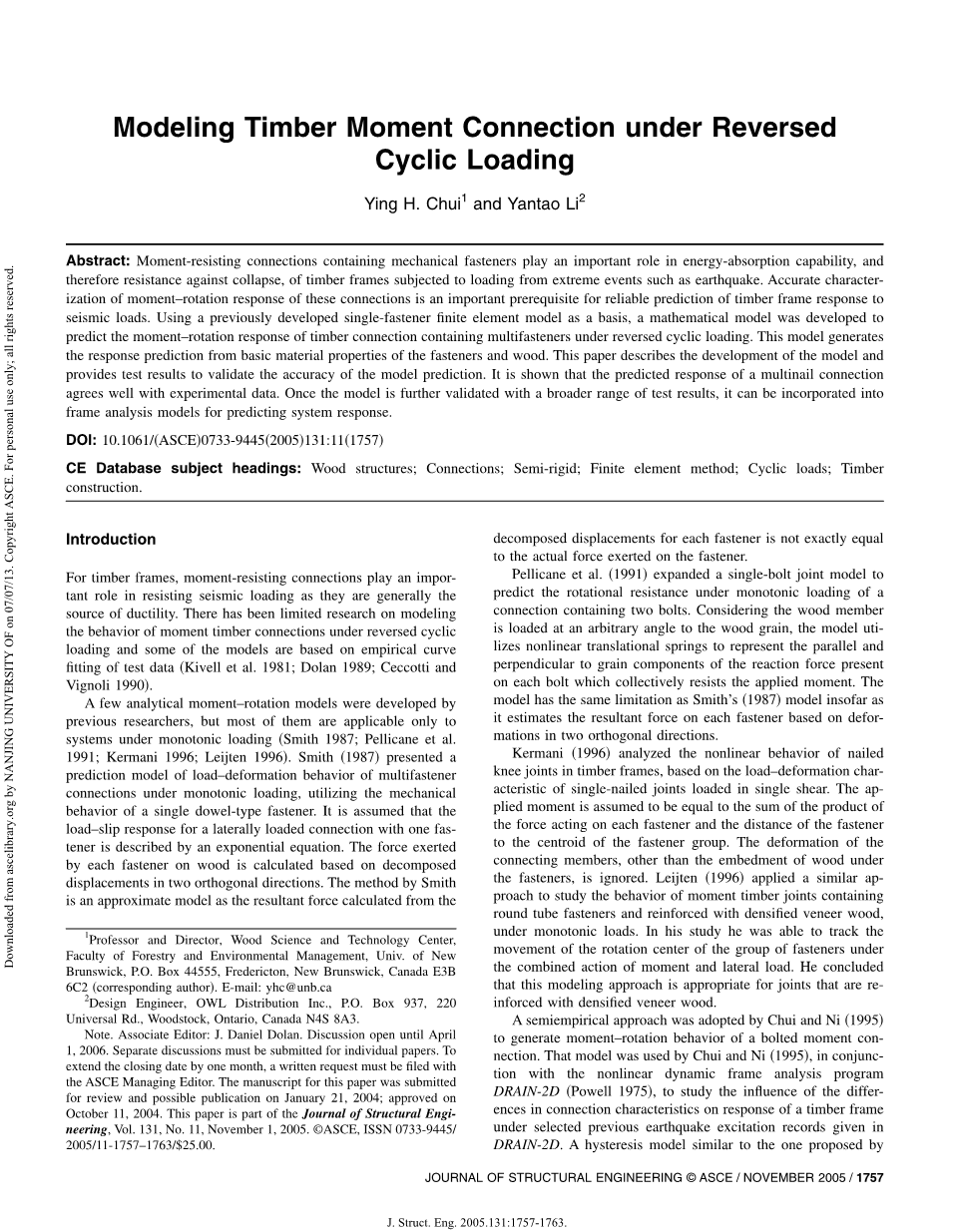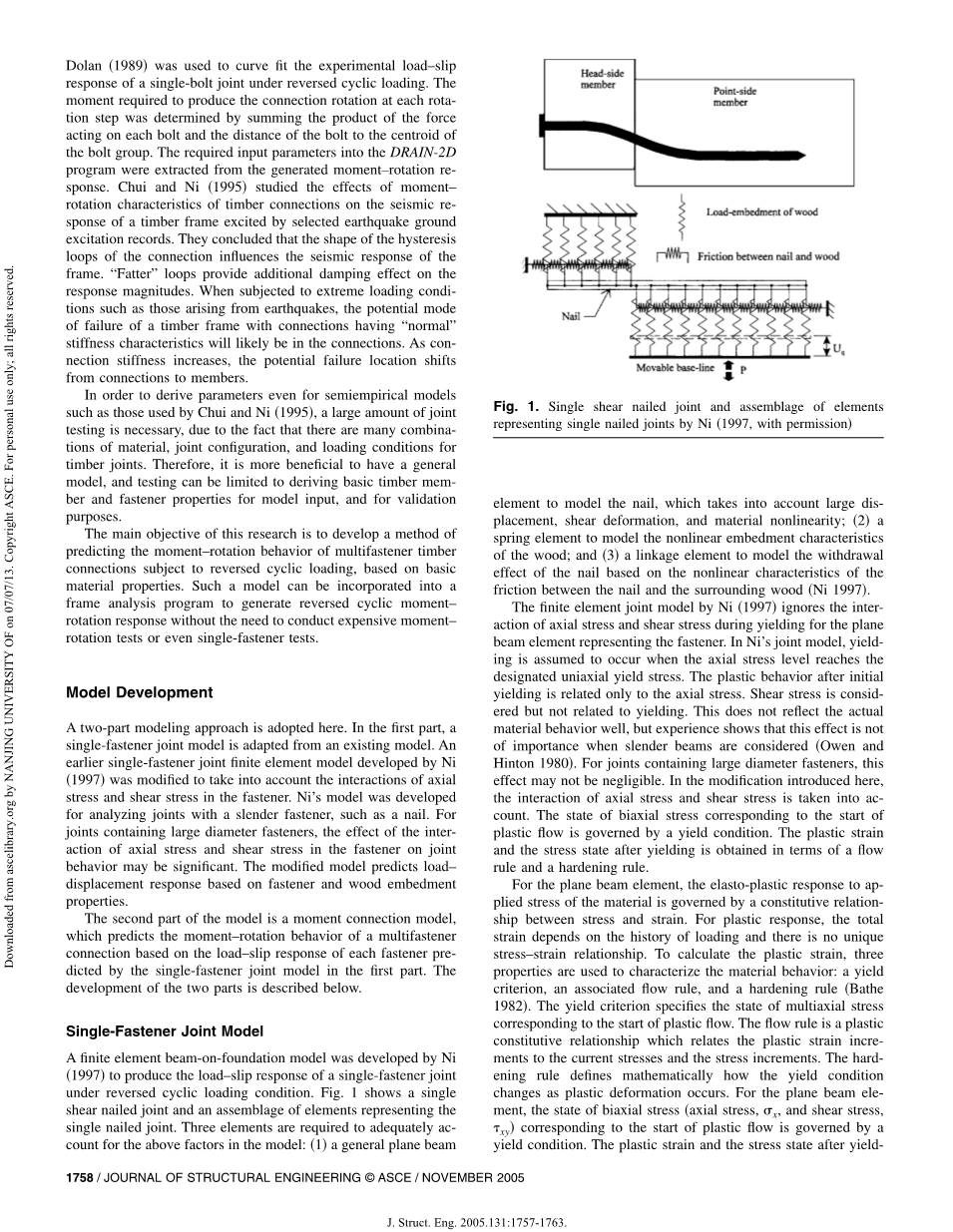

英语原文共 7 页,剩余内容已隐藏,支付完成后下载完整资料
Modeling Timber Moment Connection under Reversed
Cyclic Loading
Ying H. Chui1 and Yantao Li2
Abstract: Moment-resisting connections containing mechanical fasteners play an important role in energy-absorption capability, and therefore resistance against collapse, of timber frames subjected to loading from extreme events such as earthquake. Accurate characterization of moment–rotation response of these connections is an important prerequisite for reliable prediction of timber frame response to seismic loads. Using a previously developed single-fastener finite element model as a basis, a mathematical model was developed to predict the moment–rotation response of timber connection containing multifasteners under reversed cyclic loading. This model generates the response prediction from basic material properties of the fasteners and wood. This paper describes the development of the model and provides test results to validate the accuracy of the model prediction. It is shown that the predicted response of a multinail connection agrees well with experimental data. Once the model is further validated with a broader range of test results, it can be incorporated into frame analysis models for predicting system response.
DOI: 10.1061/ASCE0733-94452005131:111757
CE Database subject headings: Wood structures; Connections; Semi-rigid; Finite element method; Cyclic loads; Timber
construction.
Introduction
For timber frames, moment-resisting connections play an important role in resisting seismic loading as they are generally the source of ductility. There has been limited research on modeling the behavior of moment timber connections under reversed cyclic loading and some of the models are based on empirical curve fitting of test data Kivell et al. 1981; Dolan 1989; Ceccotti and Vignoli 1990.
A few analytical moment–rotation models were developed by previous researchers, but most of them are applicable only to systems under monotonic loading Smith 1987; Pellicane et al. 1991; Kermani 1996; Leijten 1996. Smith 1987 presented a prediction model of load–deformation behavior of multifastener connections under monotonic loading, utilizing the mechanical behavior of a single dowel-type fastener. It is assumed that the load–slip response for a laterally loaded connection with one fastener is described by an exponential equation. The force exerted by each fastener on wood is calculated based on decomposed displacements in two orthogonal directions. The method by Smith is an approximate model as the resultant force calculated from the
|
Professor and Director, Wood Science and Technology Center, Faculty of Forestry and Environmental Management, Univ. of New Brunswick, P.O. Box 44555, Fredericton, New Brunswick, Canada E3B 6C2 corresponding author. E-mail: yhc@unb.ca 2 Design Engineer, OWL Distribution Inc., P.O. Box 937, 220 Universal Rd., Woodstock, Ontario, Canada N4S 8A3. Note. Associate Editor: J. Daniel Dolan. Discussion open until April 1, 2006. Separate discussions must be submitted for individual papers. To extend the closing date by one month, a written request must be filed with the ASCE Managing Editor. The manuscript for this paper was submitted for review and possible publication on January 21, 2004; approved on October 11, 2004. This paper is part of the Journal of Structural Engineering, Vol. 131, No. 11, November 1, 2005. copy;ASCE, ISSN 0733-9445/ 2005/11-1757–1763/$25.00. |
decomposed displacements for each fastener is not exactly equal to the actual force exerted on the fastener.
Pellicane et al. 1991 expanded a single-bolt joint model to predict the rotational resistance under monotonic loading of a connection containing two bolts. Considering the wood member is loaded at an arbitrary angle to the wood grain, the model utilizes nonlinear translational springs to represent the parallel and perpendicular to grain components of the reaction force present on each bolt which collectively resists the applied moment. The model has the same limitation as Smithrsquo;s 1987 model insofar as it estimates the resultant force on each fastener based on deformations in two orthogonal directions.
Kermani 1996 analyzed the nonlinear behavior of nailed knee joints in timber frames, based on the load–deformation characteristic of single-nailed joints loaded in single shear. The applied moment is assumed to be equal to the sum of the product of the force acting on each fastener and the distance of the fastener to the centroid of the fastener group. The deformation of the connecting members, other than the embedment of wood under the fasteners, is ignored. Leijten 1996 applied a similar approach to study the behavior of moment timber joints containing round tube fasteners and reinforced with densified veneer wood, under monotonic loads. In his study he was able to track the movement of the rotation center of the group of fasteners under the combined action of moment and lateral load. He concluded that this modeling approach is appropriate for joints that are reinforced with densified veneer wood.
A semiempirical approach was adopted by Chui and Ni 1995 to generate moment–rotation behavior of a bolted moment connection. That model was used by Chui and Ni 1995, in conjunction with the nonlinear dynamic frame analysis program DRAIN-2D Powell 1975, to study the influence of the differences in connection characteristics on response of a timber frame under selected previous earthquake excitation records given in DRAIN-2D. A hysteresis model similar to the one proposed by Dolan 1989 was used to curve fit the experimental load–slip response of a single-bolt joint under reversed cyclic loading. The moment required to produce th
剩余内容已隐藏,支付完成后下载完整资料
资料编号:[613101],资料为PDF文档或Word文档,PDF文档可免费转换为Word


